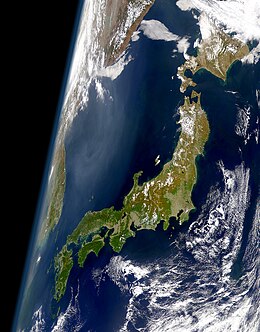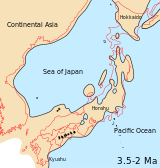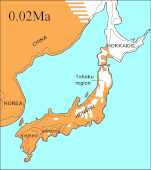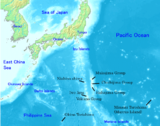Japanese archipelago
 A satellite image of the main archipelago (Ryukyu Islands and South Kuril Islands not pictured) | |
 | |
| Geography | |
|---|---|
| Coordinates | 36°N 138°E / 36°N 138°E |
| Area | 377,975 km2 (145,937 sq mi) |
| Administration | |
Japan | |
The Japanese archipelago (Japanese: 日本列島, Nihon Rettō) is an archipelago of 14,125 islands that form the country of Japan.[1] It extends over 3,000 km (1,900 mi)[2] from the Sea of Okhotsk in the northeast to the East China and Philippine seas in the southwest along the Pacific coast of the Eurasian continent, and consists of three island arcs from north to south: the Northeastern Japan Arc, the Southwestern Japan Arc, and the Ryukyu Island Arc. The Daitō Islands, the Izu–Bonin–Mariana Arc, the Kuril Islands, and the Nanpō Islands neighbor the archipelago.
Japan is the largest island country in East Asia and the fourth-largest island country in the world with 377,975.24 km2 (145,937.06 sq mi).[3][4] It has an exclusive economic zone of 4,470,000 km2 (1,730,000 sq mi).[5]
Terminology
[edit]The term "Mainland Japan" is used to distinguish the large islands of the Japanese archipelago from the remote, smaller islands; it refers to the main islands of Hokkaido, Honshu, Kyushu, and Shikoku.[6] From 1943 until the end of the Pacific War, Karafuto Prefecture (south Sakhalin) was designated part of the mainland. Geographically speaking the term "mainland" is somewhat inaccurate, as this refers to an expanse of territory that is attached to a continental landmass.
The term "home islands" was used at the end of World War II to define the area where Japanese sovereignty and constitutional rule of its emperor would be restricted.[citation needed] The term is also commonly used today to distinguish the archipelago from Japan's colonies and other territories.[7]
Palaeogeography
[edit]-
Japanese archipelago, Sea of Japan and surrounding part of continental East Asia in Early Miocene (23–18 Ma)
-
Japanese archipelago, Sea of Japan and surrounding part of continental East Asia in Middle Pliocene to Late Pliocene (3.5–2 Ma)
-
Japanese archipelago at the Last Glacial Maximum about 20,000 years ago, thin black line indicates present-day shorelines:Vegetated landUnvegetated landOcean
Geography
[edit]The archipelago consists of 14,125 islands[1] (here defined as land more than 100 m in circumference), of which 430 are inhabited.[8] The five main islands, from north to south, are Hokkaido, Honshu, Shikoku, Kyushu, and Okinawa.[6] Honshu is the largest and referred to as the Japanese mainland.[9]
The topography is divided as:
- Hokkaido, Honshu, and Shikoku and its surrounding islands;
- Kyushu and the Ryukyu arc, which is composed of the Ryukyu Islands and other surrounding islands;
- Eastern part of Hokkaido and the Kuril Islands;
- Nanpō Islands and the Izu Peninsula (part of Izu-Bonin-Mariana Arc).
Image gallery
[edit]-
The Nanpō Islands stretch to the southeast and are administered by the Tokyo Metropolis.
-
The Ryukyu Islands, which stretch towards Taiwan, are administered by Kagoshima Prefecture and Okinawa Prefecture.
-
Seabed relief map, showing surface and underwater terrain and islands such as Minami-Tori-Shima, Benten-jima, Okinotorishima, and Yonaguni
See also
[edit]References
[edit]- ^ a b "Recount with digital map leads to doubling of listed Japanese islands". Japan Times. Feb 15, 2023. Archived from the original on Feb 15, 2023.
- ^ "Water Supply in Japan". Ministry of Health, Labour and Welfare. Archived from the original (website) on January 26, 2018. Retrieved 2018-09-26.
- ^ "Island Countries Of The World". WorldAtlas.com. Archived from the original on 2017-12-07. Retrieved 2019-08-10.
- ^ "令和元年全国都道府県市区町村別面積調(10月1日時点), Reiwa 1st year National area of each prefecture municipality (as of October 1)" (in Japanese). Geospatial Information Authority of Japan. 26 December 2019. Archived from the original on 15 April 2020. Retrieved 2 January 2020.
- ^ "日本の領海等概念図". 海上保安庁海洋情報部. Archived from the original on August 12, 2018. Retrieved 12 August 2018.
- ^ a b 離島とは(島の基礎知識) [what is a remote island?]. MLIT (Ministry of Land, Infrastructure, Transport and Tourism) (in Japanese). Ministry of Land, Infrastructure, Transport and Tourism. 22 August 2015. Archived from the original (website) on 2007-11-13. Retrieved 9 August 2019.
MILT classification 6,852 islands(main islands: 5 islands, remote islands: 6,847 islands)
- ^ Milton W. Meyer, Japan: A Concise History, fourth ed. Lanham, Maryland: Rowman & Littlefield, 2012, ISBN 9780742541184, p. 2 Archived 2023-02-26 at the Wayback Machine.
- ^ "Islands in Abundance". Look Japan. Vol. 43, no. 493–504. Limited. 1997. p. 35. Archived from the original on 2023-02-26. Retrieved 2015-10-18.
- ^ "Japanese Archipelago" Archived 2018-09-19 at the Wayback Machine, TheFreeDictionary.com, retrieved 24 June 2013.






